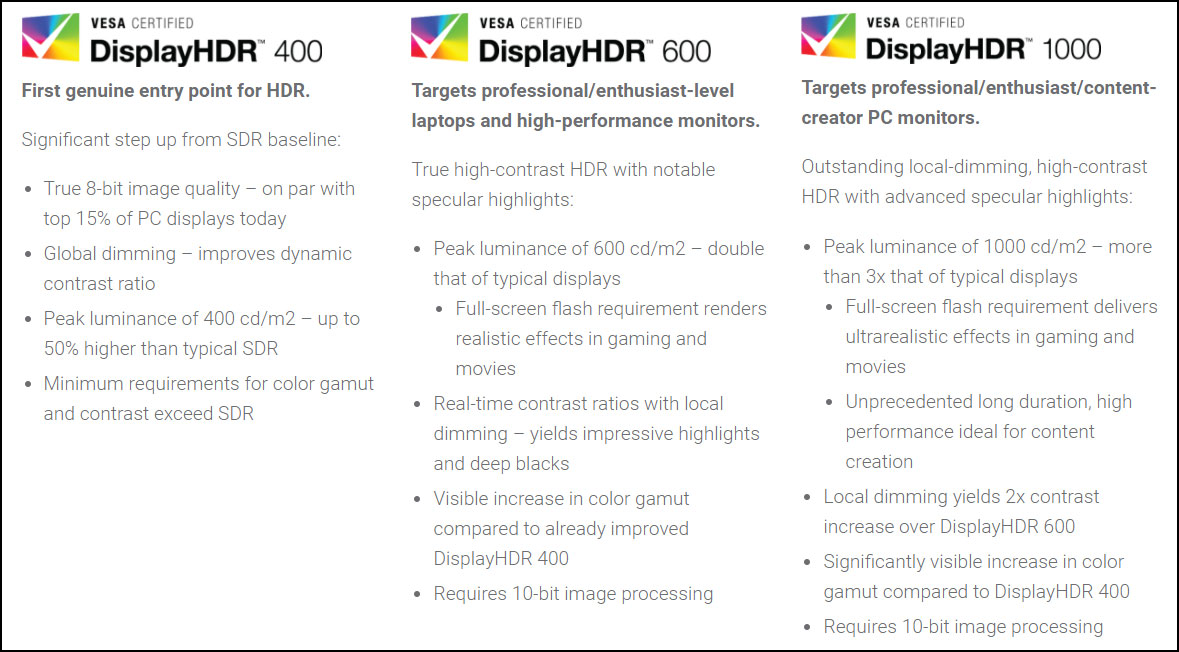Shopping for a monitor is difficult enough, and that is only amplified when you toss HDR into the mix. That’s because not all displays are created equal, and by extension, not every monitor handles HDR content the exact same. To help sift through the options, the Video Electronics Standards Association (VESA) has created a new and fully open standard specifying HDR called DisplayHDR.
“HDR logos and brands abound, but until now, there has been no open standard with a fully transparent testing methodology. Since HDR performance details are typically not provided, consumers are unable to obtain meaningful performance information. With DisplayHDR, VESA aims to alleviate this problem,” Vesa explains.
VESA developed the new spec with input from more than a two dozen active member companies, including major OEMs that make displays, graphics cards, CPUs, panels, display drivers, and other components. Color calibration providers also gave their input.
The initial DisplayHDR version 1.0 focuses on LCD panels, as they encompass the vast majority of the display market—over 99 percent, according to VESA. Future release will take into account OLED and other display technologies as they become more common, along with higher levels of HDR performance.
Vesa’s goal here is to facilitate the adoption of HDR throughout the PC market. That’s been a challenge so far due to reluctant developer support, compounded by having to put extra research into a monitor’s true HDR capabilities. It’s the latter that Vesa’s standard can help with.

DisplayHDR 1.0 establishes three distinct levels of HDR performance, labeled DisplayHDR 400 (baseline), DisplayHDR 600 (midrange), and DisplayHDR 1000 (high-end). These levels are established and certified using a set of specific parameter requirements.
One of them is luminance. The baseline spec calls for a peak luminance rating of 400 nits, which Vesa says is up to 50 percent higher than a typical SDR monitor, while the midrange and high-end specs up that figure to 600 and 1,000 nits, respectively.
“We selected 400 nits as the DisplayHDR specification’s entry point for three key reasons,” said Roland Wooster, chairman of the VESA task group responsible for DisplayHDR, and the association’s representative from Intel Corp. for HDR display technology. “First, 400 nits is 50 percent brighter than typical SDR laptop displays. Second, the bit depth requirement is true 8-bit, whereas the vast majority of SDR panels are only 6-bit with dithering to simulate 8-bit video. Finally, the DisplayHDR 400 spec requires HDR10 support and global dimming at a minimum. With this tiered specification, ranging from baseline to high-end HDR performance levels, PC makers will finally have consistent, measurable HDR performance parameters. Also, when buying a new PC, consumers will be able to view an HDR rating number that is meaningful and will reflect actual performance.”
This will not negate the need to do your research before purchasing a monitor, but should make it easier to wade through a growing number of options.
We will get our first look at DisplayHDR-certified monitors at the Consumer Electronics Show in Las Vegas next month. Following that, we suspect they will show up in the marketplace not long after.
